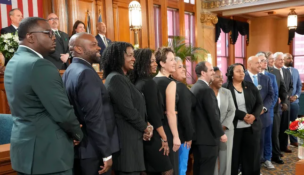Technology gives judges alternatives for jury instructions
By: Jack Zemlicka, [email protected]//November 2, 2011//
Technology gives judges alternatives for jury instructions
By: Jack Zemlicka, [email protected]//November 2, 2011//
Rather than just reading 19 pages of jury instructions to the people who would decide if Jesus Gonzalez was guilty of murder, Milwaukee Judge Richard Sankovitz mixed in some visuals.
The felony court judge on Thursday supplemented his verbal instructions with slides showing an abbreviated description of the charges and juror responsibilities.
“I watched the jury, and when there was something on the display, they were all actively involved and listening,” Sankovitz said. “When all they could do is listen and not see, I could tell they strained and were not as actively involved.”
Sankovitz, who also gave jurors a written copy of the instructions to refer to during deliberations, acknowledged not everyone approves of divergences from the traditional spoken directions.
“I’ve heard concerns that jurors don’t listen to the rest of the instructions and only emphasize a PowerPoint presentation,” he said. “Anytime judges do this, it’s a question of emphasis and completeness.”
But Sankovitz said he made sure not to overstate instructions that would somehow bias jurors. The goal, he said, was to remind jurors of the importance of their jobs, especially during a complex case.
Gonzalez was charged with first-degree intentional homicide in a May 2010 shooting that left one man dead and another paralyzed.
After more than four hours of deliberation, the jury found Gonzalez guilty of first-degree reckless homicide and first-degree reckless injury.
Luther Jackson, a first-time juror on the case, said the slides didn’t influence him, but they did keep him interested and gave him a better understanding of the applicable law and the charges.
“Some of the jurors didn’t even read the instructions when we were deliberating,” he said. “So I think it was good that he showed them on a screen to point out the law.”
Portage County Judge Fred Fleishauer said he has used PowerPoint presentations more than a dozen times for jury instruction. They come in handy, he said, to illustrate to jurors the elements of a criminal offense and what they should look for.
“Sometimes, I’ve done the entire instructions on the screen,” Fleishauer said. “I always inform lawyers of what I am proposing to do, so they have a chance to object before it’s done.”
So far, Fleishauer said, no attorneys have voiced concerns to him about using technology for juror instructions.
Still, he and Sankovitz are in the minority of state court judges who use visuals to accompany standard jury instructions.
One of the reasons, said former Waukesha County Circuit Judge Kathleen Stilling, is because visuals divert jurors’ focus from the judge’s verbal instructions.
“I think it would be an interruption in interaction between the judge and jury,” said Stilling, now a criminal defense attorney with Buting, Williams & Stilling SC in Brookfield. “It takes away from the impact that the judge can have in terms of reinforcing what they are hearing.”
But opinions vary even among criminal defense attorneys. Anthony Cotton, of Waukesha-based Kuchler and Cotton Law Offices, said juror instructions are often at least 10 pages long, depending on the complexity of the case, and secondary sources of explanation can only help.
“Unless judges are bolding certain language,” Cotton said, “I think anything that gets jurors to pay more attention shouldn’t be frowned on by anybody.”
He said he plans to request a visual supplement to traditional juror instructions at the next trial he handles.
Still, Sankovitz and Fleishauer said they don’t expect technology will be commonplace anytime soon because most judges and lawyers are accustomed to the standard method of instruction. That didn’t stop them from suggesting a study of how visual instructions affect a jury’s comprehension of a case.
In the Gonzalez case, Sankovitz said, he viewed his role as helping jurors make the most informed decision they could.
“It just stands to reason that in our culture, we learn through visual images,” he said. “If we are really intent on instructing jurors and teaching them, then this is a way to do that.”
Legal News
- Wisconsin joins Feds, dozens of states to hold airlines accountable for bad behavior
- Trump ahead of Biden in new Marquette poll
- New Crime Gun Intelligence Center to launch in Chicago
- Arrest warrant issued for Minocqua Brewing owner who filed Lawsuit against Town of Minocqua
- Wisconsin Supreme Court justices question how much power Legislature should have
- Milwaukee’s Common Council now has the most African Americans, women and openly LGBTQ members ever
- Office of School Safety Provides Behavioral and Threat Assessment Management Training Ahead of 25th Anniversary of Columbine Shooting
- Wisconsin Supreme Court to hear arguments in Democratic governor’s suit against GOP-led Legislature
- Lawsuit asks Wisconsin Supreme Court to strike down governor’s 400-year veto
- Wisconsin man pleads not guilty to neglect in disappearance of boy
- ACS Selects University of Wisconsin Law School’s Miriam Seifter for 2024 Ruth Bader Ginsburg Scholar Award
- People with disabilities sue in Wisconsin over lack of electronic absentee ballots
WLJ People
- Power 30 Personal Injury Attorneys – Russell Nicolet
- Power 30 Personal Injury Attorneys – Benjamin Nicolet
- Power 30 Personal Injury Attorneys – Dustin T. Woehl
- Power 30 Personal Injury Attorneys – Katherine Metzger
- Power 30 Personal Injury Attorneys – Joseph Ryan
- Power 30 Personal Injury Attorneys – James M. Ryan
- Power 30 Personal Injury Attorneys – Dana Wachs
- Power 30 Personal Injury Attorneys – Mark L. Thomsen
- Power 30 Personal Injury Attorneys – Matthew Lein
- Power 30 Personal Injury Attorneys – Jeffrey A. Pitman
- Power 30 Personal Injury Attorneys – William Pemberton
- Power 30 Personal Injury Attorneys – Howard S. Sicula











